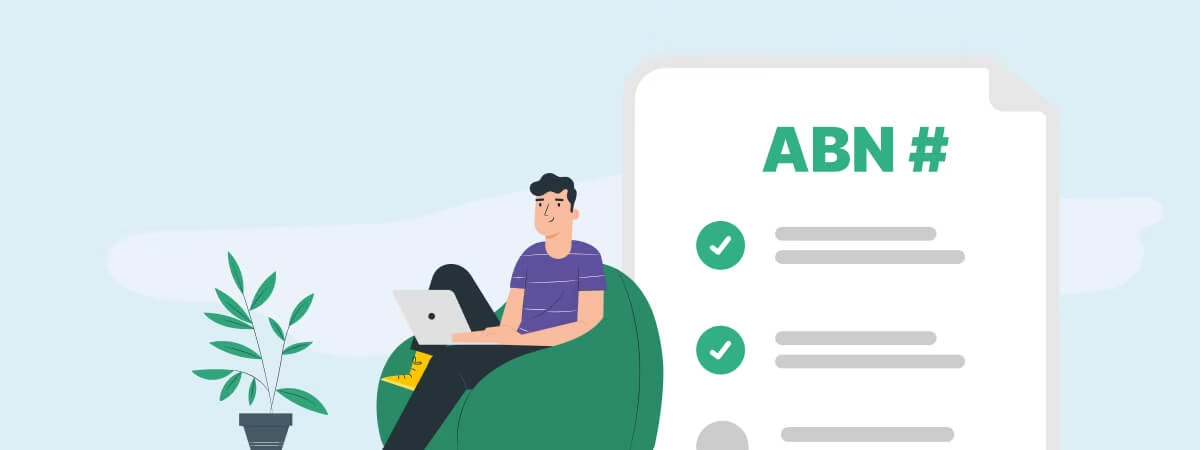If you’re a sole trader working in Australia, you’re likely to have heard of an Australian Business Number (ABN). In fact, you probably already have one (good for you!).
An ABN is a special set of 11 digits that allows you to identify your business with government departments and agencies. Like the Australian Tax Office (ATO), which every income earner in Australia has to liaise with, or the Australian Business Register (ABR), which is where the details of your ABN are stored.
Having one is handy, but it doesn’t replace your Tax File Number (TFN), they’re two totally different things – fortunately, you can have two special numbers to your name. Think of it this way: all people earning an income in Australia need a TFN in order to pay their taxes and make tax claims. Most, but not all, business owners will have an ABN. If you’re not operating a business it’s likely that you don’t need, or actually aren’t entitled to, an ABN.
Let’s take a look at a) what an ABN does and b) why it might be necessary or useful to you as a business owner.

What is an ABN?
Ultimately, it’s a unique number that flags you as someone who provides goods and/or services to others. Your ABN is public information, available to anyone who wants to find it. It’s kept safe by the ABR and it helps other businesses or government bodies identify your business. You can only have an ABN if you’re operating a business.
However, you’re not required to have one, per se. You only need an ABN attached to your business if you’re registered for GST – but you can also obtain one even if you aren’t registered for GST (bear with us, we promise this can be broken down and made easily digestible, unlike the large plate of mexican food you had last night).
If you expect to make $75,000+ in the next 12 months, you’re required to register for GST immediately. And because you’re registered for GST, you’re required to have an ABN. Essentially, the ABN always comes first, and the GST comes second and is dependent on your income.
All that being said, if you’re earning under that amount and don’t need an ABN, it could still be useful to have one, particularly if you’re a sole-trader.
Why is an ABN relevant to sole traders?
If you’re choosing to operate your business without an ABN, some businesses may be required to withhold nearly half (47%) of any payments they make to you for tax purposes. This is known as pay as you go withholding (PAYG) and can occur if you don’t provide an ABN.
Having an ABN can help you avoid this high rate of withholding tax, and if you still find calculating and setting aside tax confusing, you can lean on an accounting service like Hnry to sort that stuff out for you (but you didn’t hear that from us).
The uses of an ABN for sole traders
Beyond using an ABN to avoid a high rate of withholding tax, there’s a number of different ways it could be useful to you as a sole trader:
- You can pop the number on your invoices to make you easily identifiable to clients and customers
- If you’re GST registered you can claim GST credits. Hence why, if you are registered for GST, the ABN is a must – it always comes first, remember? It’s all coming together!
- You can use your ABN as commercial ID when registering an Australian domain name – ideal if you’re planning to build a website to showcase your immeasurable talents
- You can use it to claim an Energy Efficiency Grant, to cover upgrades of energy inefficient equipment and hopefully lower your energy bill
How to find your ABN
If you already have an ABN (or think you might), but can’t remember what it is, don’t worry. They’re really easy to look up – it’s not like finding a needle in a haystack.
If you head to the ABR website there’s a handy little search bar that you can chuck your personal name or business name into to find your unique 11 digit number. The search will narrow down a handful of business names and entities, and you should be able to identify yours by the corresponding location in the right-hand column.
Once you select the item, it’ll be pretty obvious whether that ABN belongs to you or not (your name will be listed as the entity i.e. the business).
How to get an ABN
If you don’t have an ABN, applying for one is fairly straightforward – it shouldn’t take more than 30 minutes in total. 10-15 minutes to get through the application process, and another 10 minutes for the ABN to land in your inbox. Best of all, it’s completely free!
Firstly, before you jump in, it’s best if you decide on the structure of your future business first: are you going to operate as a sole trader or a company?
If you decide that a sole trader structure is right for you, there are a few things you want to have handy to make the process a lot smoother – and you might not have all of these things, which is totally OK. Just grab what you do before you launch in.
- Your TFN. If you don’t have this written down somewhere, you can log in to your MyGov account and head to your linked ATO service to find it.
- The date which you plan to begin using your ABN.
- Your legal name (this one should be pretty easy)
- The contact details for your business. This should include the usual suspects: a postal address, email address, and phone number.
- What your business activity will be (ie graphic design, electrician, beautician etc).
- Any business locations or enterprises – wherever you will be operating your business from.
After you’ve got all this information ready, you need to make the call on whether to register for GST. If you’re projected to earn more than $75k in the next 12 months, you’re required to register for GST, and can do so as part of the ABN registration. If you’re not, you can still register for GST at a later date.
However, if you do decide to register, you need to be sure to add GST on top of your product prices/service fees.
Lastly, registering for an ABN is totally free.

ABNs and your Business Name
What happens if you register for an ABN as a sole trader, and don’t register for a business name? Nothing! You can totally just have the ABN attached to your legal name. If down the track, you decide to brand your business with a funky name, it’s really easy to attach this new identity to your ABN.
If you decide to register a business name, you’ll first need to make sure the business name is available and not already in use.
If you head to the Australian government business registration site you can look up your proposed business name and see whether this it’s available for your use, or already taken by your arch nemesis.
Once you have an available business name ready to rock, head to the Registrations tab on the same website. You’ll be able to follow the prompts and either apply for an ABN and business name at the same time, or simply a business name and attach it to your existing ABN – you’ll even have the option to register for GST if you didn’t do it the first time around, but now you’re bank rolling and need to do the right thing.
Can you have multiple ABNs?
Short answer: yes. But, you can actually conduct any number of businesses or services under the one ABN, so long as they all follow the same structure. Eg, if your ABN is for sole trader purposes, each branch underneath it needs to be for sole trader purposes.
If you have more than one business (look at you!) and they operate under different structures (say, one is a company and the other you work as a sole trader) then these businesses will need their own, individual ABN.
How to cancel your ABN
Cancelling your ABN is easy – you can do this online through the ABR. If you decide to close your business, you’ll be required to deregister your ABN along with it. Same goes if you’ve sold it, decided to change the structure of your business, or you’re no longer operating within Australia.
In order to go ahead, you must ensure all your taxes and debts have been paid, and all lodgements have been, ahem, lodged. Do all of this first, then you can proceed with the cancellation. Easy peasy.

ABNs and taxes
Almost everyone who has an ABN is required to lodge an annual tax return. It doesn’t matter if your business isn’t turning over a profit yet, you still need to report any and all of this income to the ATO, regardless of whether you’re earning above or below the tax-free threshold (the first $18,200 you earn annually as an individual is tax free).
All this being said, an ABN is for life. If you obtain one, so long as you’re running your business enterprise, this number will be with you til death do you part.
The ABR runs periodic checks to ensure your ABN is still being put to good use and it’s ultimately up to you to ensure all the details relating to your ABN are up-to-date.
The easiest way to flag to the government that your ABN is still alive and ticking is by keeping your tax returns and lodgements up to date.
Hnry sorts your taxes for you
We’re probably biased, but we really believe that the best way to sort your taxes is by using Hnry.
Hnry pays your taxes throughout the year, so you’ll never have to think about tax again.
If the amount you earn fluctuates from month to month, Hnry automatically adjusts your income tax rate as you go to ensure that you pay the exact right amount of all your taxes – whenever you get paid.
That means:
- No more under or over-paying your Income Tax.
- No more worrying about your other taxes like GST, or your Medicare Levy – Hnry takes care of all your taxes for you, and lodges all your returns on your behalf.
- No need to pay for a separate accountant and multiple software tools to handle your financial admin – Hnry is an all-in-one service.
Our team of accountants and tax experts, and our award-winning software, have got your back.
Join Hnry today!
Share on:

